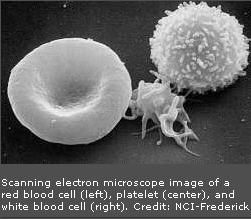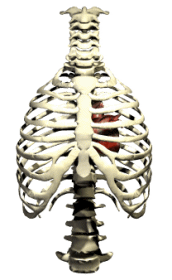CARDIOVASCULAR SYSTEM : BLOOD, HEART, VESSELS
BLOOD
![]()
I Composition
A. Plasma
1. proteins
a. gamma globulins
b. fibrinogen
c. albumin
B. Formed elements

1. erythrocytes (RBCs)
a. function
b. hemoglobin
c. structure of RBC
d. recycling
1. bilirubin
e. erythropoiesis
1. hemocytoblasts
2. erythropoietin
f. anemia
g. blood groups
1. ABO antigens
a. agglutination (clumping)
b. universal recipient; universal donor
2. Rh antigens
a. Rh- mom with Rh+ baby
2. leukocytes (WBCs)
a. general function
b. location
c. comparisons to RBC
d. types
1. granulocytes
a. neutrophils
b. eosinophils
c. basophils
2. agranulocytes
a. monocytes
b. lymphocytes: specific defense
1. B-cells; humoral immunity
2. T-cells; cell-mediated immunity
3. platelets (thrombocytes)
a. hemostasis
1. plug formation
2. clot formation
At the end of this unit you should be able to:
|
|
- list the components of the plasma and what they do - describe the structure of an erythrocyte and how its structure fits its function - explain the process of erythropoiesis - draw a RBC from each of the ABO blood groups and the antibody that accompanies it - determine the possible donors and recipients of each type - the problems that can occur if a mother is Rh- - compare similarities and differences of leucocytes and erythrocytes - list the WBCs which provide non-specific immunity and explain what each does - explain the difference between specific and non-specific immunity - identify the WBCs in charge of specific immunity - explain the difference between the two types of specific immunity - explain how a platelet plug is formed - explain how a blood clot is formed - compare and contrast a platelet plug and a blood clot |
HEART

I Heart
A. Structure
1. two pump system
a. right heart pumps to the lungs
b. left heart pumps to the rest of the body
2. valves
a. atrioventricular: tricuspid, bicuspid (mitral)
1. chordae tendineae
b. semilunar valves (pulmonary, aortic)
c. function
d. dysfunction: stenotic, insufficient
B. Pathways of blood flow
1. pulmonary circulation
2. systemic circulation
3. coronary circulation
a. disorders
1. angina pectoris
2. myocardial infarction
b. repairs
1. angioplasty
2. coronary bypass
C. Intrinsic Conduction System
1. definition
2. structure
a. sinoatrial node (SA node); pacemaker
b. atrioventricular node (AV node); nodal delay
c. Bundle of His, Bundle branches
d. Purkinje fibers
3. function
4. dysfunction
D. Cardiac cycle
1. atrial systole
2. ventricular systole
3. diastole
E. Cardiac Output
1. definition (CO = SV x HR)
a. stroke volume (ml/beat)
b. heart rate (beats/min)
2. heart rate regulation
a. cardiac center of medulla via autonomic nervous system
1. sympathetic
2. parasympathetic
At the end of this unit you should be able to:
|
|
- compare the structure and the function of the right heart and the left heart - explain how the atrio-ventricular valves prevent backflow, how their structure fits their function - explain how the semilunar valves prevent backflow, how their structure fits their function - explain the difference between stenosis and insufficiency of a heart valve - list the structures the blood passes through as it goes through the heart - define angina pectoris, myocardial infarction, angioplasty, coronary bypass - list the structures of the intrinsic conduction in order - explain the necessity for the intrinsic conduction system in the heart - describe two common malfunctions of the intrinsic conduction system - explain what is occurring in each of the stages of one cardiac cycle : atrial systole, ventricular systole, diastole - distinguish between cardiac output and stroke volume - calculate the cardiac output when given a stroke volume and heart rate - explain how heart rate is increased or decreased to meet the needs of the body |
VESSELS AND BLOOD PRESSURE
I Blood Vessels
A. Arteries
1. elastic, thick-walled
2. recoil, high pressure
B. Arterioles
1. smooth muscle
2. vasoconstrict and vasodilate
C. Capillaries
1. thinnest walls
2. exchange vessels
3. capillary beds
D. Venules to Veins
1. thin walls, large lumen, valves
2. low pressure, low resistance, storage
a. skeletal muscle pump
3. varicose veins
II Pulse and Blood Pressure
A. Pulse
1. definition
2. pressure points
B. Blood pressure
1. definition; systolic and diastolic
2. pressures in the circuit
3. factors
a. cardiac output
b. blood volume
c. peripheral resistance
1. definition
2. blood vessel diameter
a. vasoconstriction
b. vasodilation
d. viscosity
4. hypertension ---> congestive heart failure
Questions you should be able to answer at the end of this unit:
|
|
- compare the structure of arteries, veins, and capillaries - compare the functions of the three types of vessels - describe how the skeletal-muscle pump works - define pulse and list pressure points - list the major factors which contribute to blood pressure - explain how changing the diameter of blood vessels affects blood pressure - define congestive heart failure - explain how chronic hypertension can lead to congestive heart failure |
return to A&P outlines
return to A&P
return to homepage